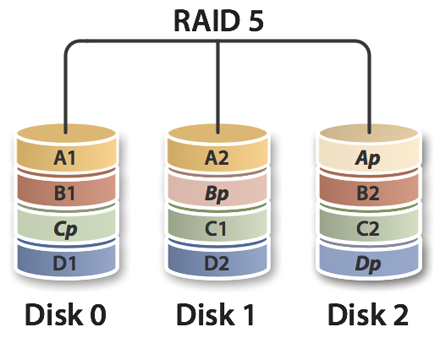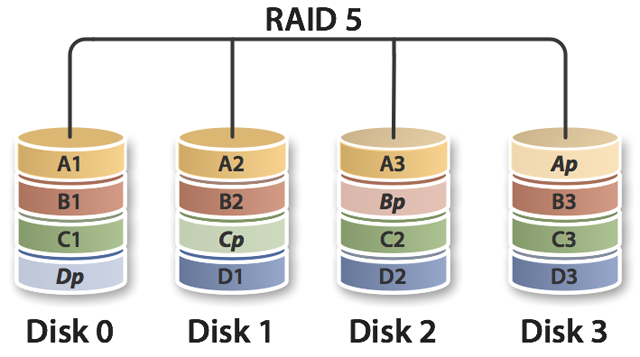Of course, something for something: RAID 1 is resistant to a configuration of up to three disk failure, RAID 1E, 5EE, 6, and 10 two, and RAID 5, as is easy to guess only one. The data are stored on disk in the form of strips n-1 and one strip parity. In opposite to RAID 3 and RAID 4 (which not described), because RAID 5 replaced them, the parity data is distributed across all disks included in the array. Matrix of the fifth level is similar of RAID 1 is characterized by asymmetry of performance, ie the reading is better than on a single disk, while the record (depend the implementation) may be even slower. In addition, performance of defectivematrix can be decreased.

RAID 5 for each "row" of strips spread across on all component disks has a one block which is checksum of other. If during an active recording on RAID 5, the system crashes, it is likely that the parity block is not in accordance with blocks of data. What if won't undetected before the disk failure, or damage the block, it may result incorrect data reconstruction. This attribute is sometimes referred to as write hole. Protection against of this example is the battery's securing the cache. In RAID 5 when overwriting one or more blocks, overwrite must be also (one more time recalculated) checksum. This causes a very large overhead on the controller and drives when working on large numbers of very small files. So operation is reduced to:
- Read the old data block
- Read the old parity block
- Comparisons of the old block to the write requests and calculate of parity
- Saving the new data block
- Saving the new parity block
Therefore, write operations to RAID 5 are quite demanding in terms of operations on the drives and bandwidth between the controller and drives. Furthermore, the RAID firmware and software RAID all operations checksum calculation are performed on the processor. Parity blocks are not read during a typical reading of the data, since it would require of a big the overhead and fall any performance gains. These blocks are read, however, when reading data blocks will fail on one of the components of disk arrays. The checksum is then used to rebuild corrupted data. Similarly, in the event of failure of the entire disk parity data are used to rebuild on the fly. This feature is sometimes called the Provisional Reconstruction Mode of Data: The computer is informed of the failure of the matrix to give opportunity to tell this fact to the administrator, but all applications can still read and write data. Of course, this involves a degradation of performance.
If you need to recover RAID 5 please visit: http://www.InfoRecovery.com/raid-data-recovery

Procedure described above read-modify-write has influence in the write performance of RAID 5, if the operations are performed on files smaller than the stripe size. This is because each parity block such entry must be overwritten with the new checksum. What with the large number of disks means that the same parity block is repeatedly overwritten when saving data to all blocks of data in row. For this reason, RAID 5 is a weak performance in case for random records (eg for databases). More advanced implementations of RAID 5 are able to use non-volatile cache, "storing" all the smaller orders of record, and then, make a full record of the row, so stored all the data blocks and the block with converted checksum for them in one fell swoop. The performance of read remains at a similar level to RAID 0 with the same number of disks. The form of writing outside the parity stripe is virtually the same as RAID 0, and the reason for differences is the overhead associated with bypass blocks of parity.
Data Retrieval in Charlotte - raid 5 data recovery: emergency raid

